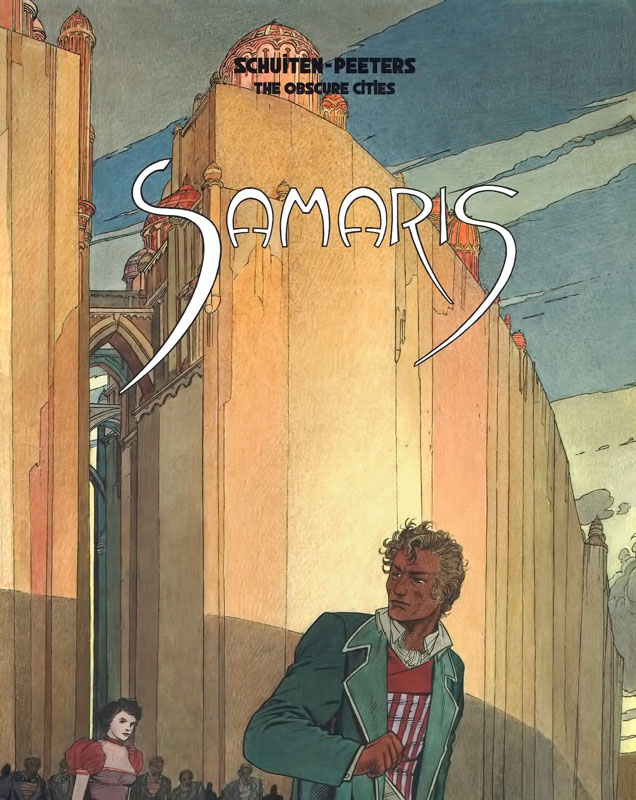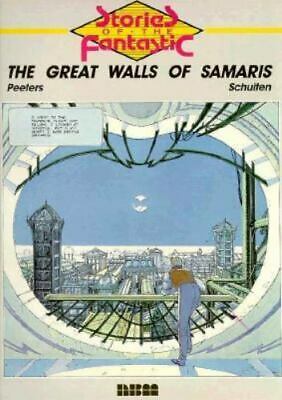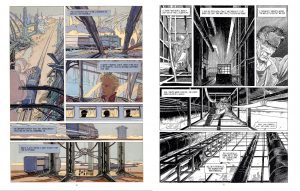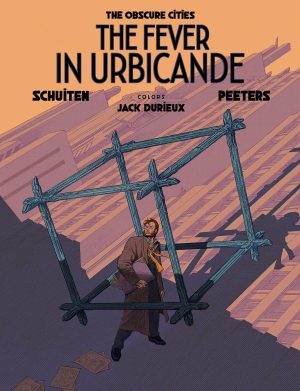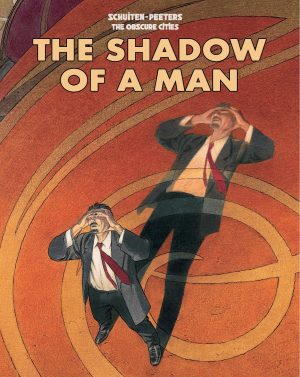Review by Woodrow Phoenix
Artist François Schuiten’s love of architecture inspired him to create the series Les Cités Obscures (The Obscure Cities) with writer Benoît Peeters. The stories take place in a retro-future world of massive, gothic and Modernist, Art Nouveau and Art Deco structures where ‘urbatectes’ (architects who design not just buildings, but cities; the entire urban environment), move society forward. Nine books were published between 1983 and 2013, each has an emphasis on a different style of architecture, and the series has won numerous international awards including a Grand Prix for Schuiten from the Angoulême International Comics Festival in 2002. The complete series has never been fully published in English. Existing translations have been out of print for years until new versions began appearing in 2020.
Samaris is volume one of François Schuiten and Benoît Peeters’ chronicles of The Obscure Cities. It’s a reworking of the original first version published in 1983 in French as Les Murailles de Samaris (The Great Walls of Samaris), a 48-page album. This new version produced twenty years later has been expanded to 96 pages and now includes The Mysteries of Pâhry parts 1-4: Part I, ‘The Great Secret’; Part II, ‘Passage to The Louvre’; Part III, ‘The Fugitive (revised)’; and Part IV, ‘The Strange Case of Dr. Abraham’, originally published in the magazines Á Suivre and Macadam-plus.
Samaris begins with Franz Bauer, a young officer accepting a mission from the leaders of his city of Xhystos, to cross the continent to the city of Samaris and find out what their rulers are planning. His friends fear he will never return, like many who undertook this assignment before him. It takes almost two months of continuous travel by train, airships and boats to reach Samaris. The colourful mixture of rococco styles is very different from the grey and blue Art Nouveau of Xhystos, and as Bauer wanders the strangely artificial streets he feels the buildings are actually reconfiguring themselves behind him as he walks among them. What he eventually discovers makes him question his own sanity, but will he able to tell anyone what he has found?
The Mysteries of Pâhry are four short episodes driven by exploration of the places they are based on; the Paris Opera, the Louvre, the Elysée Palace and the Centre Georges Pompidou where Peeters and Schuiten were given behind the scenes tours of the private or otherwise inaccessible spaces the public could never see. The stories are all about secret passages and hidden things being revealed, all atmosphere and dreamlike logic. The Mysteries of Pâhry was never completed, and these are described as fragments of the story that have been reworked several times. This book provides no resolution to any of the puzzles it lays out. Breeze through it looking for explanations, and you may find it unfulfilling. The story is rooted in the imagery and the mood those images create, with the endless searching for secrets simply a reason for the protagonists to keep moving ever further into imposing, maze-like and intricate environments.
The massive success of Fever in Urbicand, the second, much longer and more densely plotted book in this series, prompted readers to take another look at Samaris as a prequel and major source of clues for interpreting the Obscure Cities universe. Schuiten and Peeters have revised all their stories in between reprintings, some quite extensively. Fever in Urbicand, previously black and white, is now published in colour and retitled The Fever in Urbicande.
